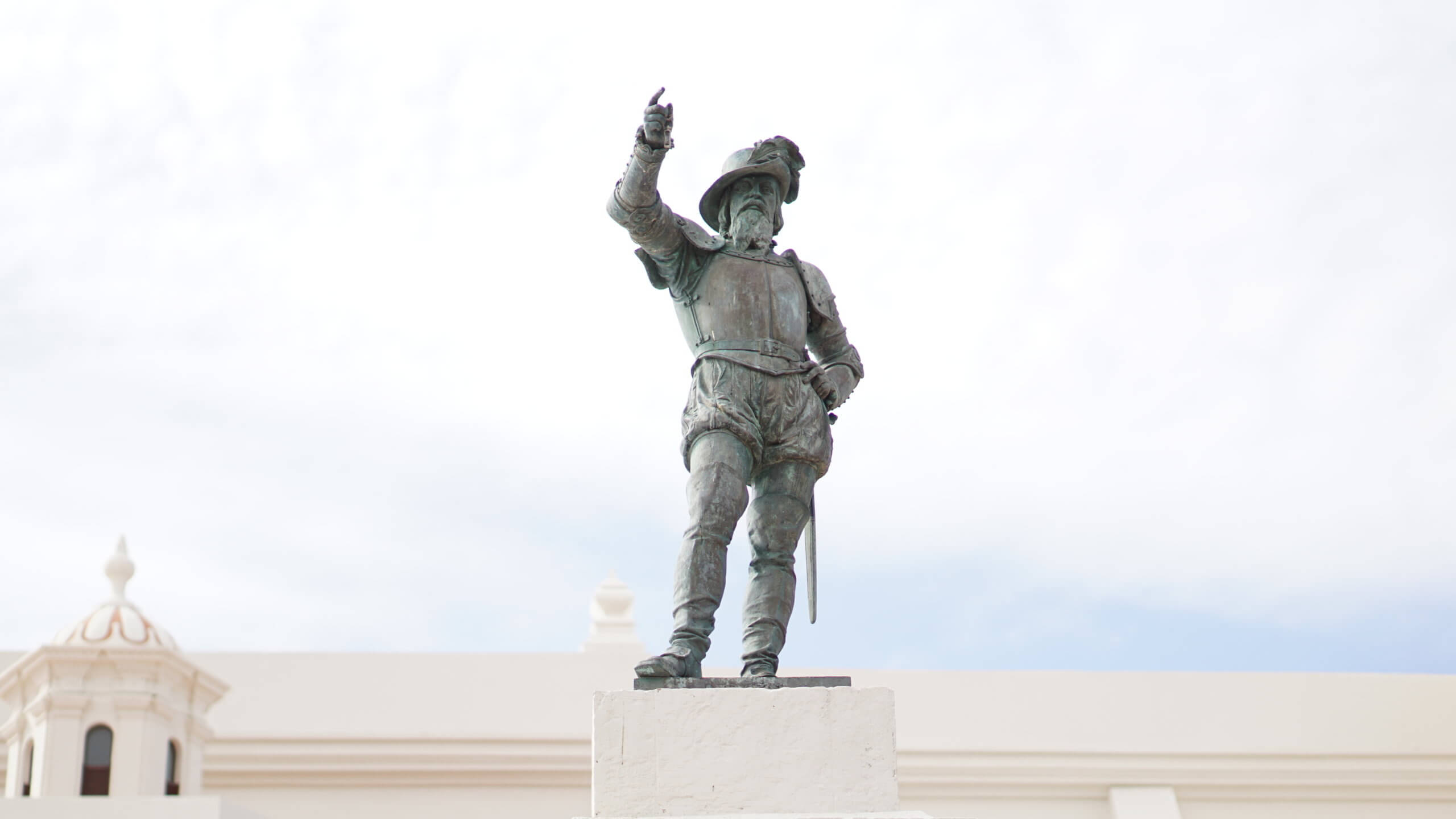Founding Mythos
Florida is an often maligned and misunderstood place. A region shrouded in mystery from its inception even until today. It is enigmatic, the subtropical womb in which the first European American civilization was born. A forgotten Catholic and Hispanic society, erased by those that came after. In many ways the history of Florida is a microcosm of American History.
Every civilization has a mythos. A mythos in this case, is deeply linked to a founding myth. Every civilization has had a founding myth, Rome had Romulus and Remus, the Greeks had Alexander the Great. A national mythos, whether true or not, is that which helps guide civilizations. They are deeply important to all peoples, they inform what matters to a civilization, what is valued and cherished. The mythos creates the identity for a civilization. When a mythos is attacked, you see that the civilization suffers. We live in a day and age where the founding myths of the New World are attacked deeply in a concerted effort to detach this New World from the Old World. Much of this effort has been directed towards Catholic Spain, with its “Black Legend”, in an effort to make people today hate their ancestors.
For the United States, the mythos has been built on the founding myths of the Puritans, Thanksgiving, and George Washington with the cherry tree, and the fact that the American Republic traces its form of government from the Ancient Roman Republic. Of course, this founding myth comes from the original thirteen British colonies. Much like the original Romans, as the United States has expanded into the rest of the continent, it has incorporated more and more different cultures into its Republic, either by conquest or by immigration. The first of those conquests of Manifest Destiny was Florida.
Catholic Florida Forgotten
In Florida, we have an incredible story. Here we see an initial civilization founded in the Catholic faith, forged by brave explorers, a civilization fighting constantly to maintain itself and then ultimately memory-holed by the writers of history, the Liberal, Protestant victors, who wrote history. In it, we see the clash of civilizations. Here we see a founding myth that was lost. Only now are we beginning to really understand and appreciate it. The history of Florida is the rest of the untold story of Christopher Columbus. But while Christopher Columbus became part of the American mythos due to the efforts of Italian Americans, the rest of the story did not. The rest of the story is decidedly Catholic and very Hispanic.
Of course, Christopher Columbus was not some lone Italian explorer, he was financed by the King and Queen of Spain in 1492, the same year when Queen Isabella saw the fall of the last Muslim stronghold in Spain on January 2nd. It seems almost providential (and intimately bound up with Our Lady) that only months later on October 12th, 1492, Columbus would sail the ocean blue and find new lands. It almost seems as if providence rewarded the Spanish Catholics with the discovery of two new continents after their 700 years of crusading in the “Reconquista” for their lands. This is the fervor that motivated the rapid expansion, exploration and fighting of the Spanish. This is the spirit in which the original explorers of Florida were raised. The original explorers were literally crusaders from the Old World and they carried that spirit into the New World.
People often do not know that Florida had the first European settlements and cities in what is today the United States of America. The first to step on these lands were not English Puritans but rather Spanish Catholics. The first permanent city established by the Spanish was St. Augustine, in 1565, which predates Jamestown, which was founded in 1607. They came to the peninsula seeking to conquer it for God, to expand Christendom. Even the very name given by the Spaniards to the peninsula “La Florida”, harkens to its Catholic History. When Juan Ponce de León (pictured above) first sighted land on Easter Sunday, 1513, he named the newly discovered land in honor of the Spanish term for Easter, “Pascua Florida.”
The Real First (Catholic) Thanksgiving
Juan Ponce was a veteran of the military campaigns against the Moors in Spain, a crusader through and through. He sailed with Columbus and later would lead his expeditions. This new land which he named was to be an extension of the Spanish Catholic society established in the Caribbean, and through the next fifty years, many hundreds of men would die in the swampy bushland, all trying to establish Christian civilization. While the Spanish would find swift success in places like Mexico and Peru, where they faced off against powerful empires, the land of Florida would prove much harder to tame. The land was inhospitable, and the natives waged brave and effective guerilla warfare against the Spanish explorers. Juan Ponce de León would find his demise by the spear. Cabeza de Vaca would be left shipwrecked, and a crew of 500 would turn into four survivors living in the wilderness for ten years, trudging through the peninsula, the bayou and Texas until making it to Mexico City. Hernando de Soto would travel all across the South, making it to the Smoky Mountains and later falling ill near Arkansas, being buried in the Mississippi. Tristán de Luna would establish the first short-lived settlement, modern-day Pensacola, which had families and a stable population, but would be abandoned after a devastating hurricane.
Finally, we come to 1565. In that year, we finally see success. Land was spotted on August 28th, and named in honor of the feast of St Augustine. The conquistadors made landfall on the Nativity of Our Lady, September the 8th. The Captain of the Spanish Treasure Fleet, Pedro Menéndez de Avilés, along with his men, established the city of St Augustine, Florida. Father Francisco López de Mendoza Grajales celebrated a solemn Mass of Thanksgiving. All present sang the “Te Deum” in gratitude to God. Afterwards they ate a celebratory meal with the local Timucua natives. This event is pointed to by historians as the “First Real Thanksgiving.” Here we see a fascinating tale of cooperation, again predating the Thanksgiving held by the English Puritans in Plymouth in 1621.

This would be the first of many cities established by the Spanish in what is now the United States, working in tandem with the cities created in the American Southwest, including California, Arizona, Nevada, Colorado, New Mexico, Utah, Wyoming and Texas. In Florida, as well as in the rest of the Spanish lands, we see native Americans being integrated into the new European society. In Florida, the Jesuits, and later Franciscans, sent missionaries and established missions all over the peninsula, as far as North Carolina and Louisiana. Truly at that point the entire South was “Floridian.” The missionaries preached the gospel to the natives, and they were taught about metallurgy, leatherworking and other European customs.

So much of the culture of the United States of America comes from those initial Spanish explorers. They brought the first horses, cattle, chickens, hogs and fruits. The orange, that most iconic of Floridian fruits, was also first brought by the Spanish. Outside of the settlements and missions sprinkled throughout the American South, we see men taking up ranching and farming, both of which have become synonymous with the American mythos.
The Original Mythos of Pocahontas?
Besides that First Thanksgiving of 1565, we also see some other fascinating stories that have become part of American culture, yet were not attributed to Florida. In 1539, Hernando de Soto would find a survivor, Juan Ortiz from a previous expedition, who had “gone native,” after being saved from execution at the hands of a native chieftan by the Uzita princess. Some historians say this may have informed the myth of Pocahontas.
Ortiz, fluent in the Timucua language, would become an interpreter for the group, as they ventured North. Eventually, in the fall, the band would make a winter encampment in present-day Tallahassee, then Apalachee territory. Since documents show that De Soto brought twelve priests, it is certain that the first Christmas Mass and celebration in the present-day US would’ve occurred here.
In 1602, we even see the first “St Patrick’s Day Parade.” In the city of St Augustine, an Irish priest led a procession through the city, in honor of Saint Patrick, and celebratory cannons were fired from the city’s fort, the Castillo de San Marco.
Black and Indian Catholic Florida
The civilization of Spanish La Florida also mirrored the modern day landscape of America. In many ways, they are not too dissimilar. Spanish Florida was made up of many different peoples, not just Spaniards. Runaway slaves, largely coming from the British Colonies, would be granted freedom and asylum if they converted to Catholicism. So Florida became home to the first settlement of free blacks in what is now the United States, establishing the settlement of Gracia Real de Santa Teresa de Mosé (Fort Mose). The inhabitants became a vital line of defense of St. Augustine against enemy attacks. The free men of Fort Mose would even stage incursions against their Northern enemies.
In Spanish Florida, you saw a society made up of Natives, Africans, Spaniards and other Europeans. What connected them all? The Catholic Faith. In order to be part of the society, Catholicism was the standard to which you had to rise. The Catholic faith was the guiding principle and the glue that held these peoples together, that which connected them as brothers in Christ. Unlike the Puritans and other heretics in the English colonies to the north, Spanish Florida created an integrated society in which Catholic Indians and Blacks intermarried with the Spanish, as in the mixed race Catholic Indian tribe, the Seminoles.
Notably, the first ever recorded Christian marriage in the continental US was also an interracial marriage. Of course, this happened in Spanish Florida as well. So many firsts! The Cathedral records write of the marriage, which occurred in St. Augustine in 1565, the same year as the city’s founding. This marriage was between Luisa de Abrego, a full-blooded African woman (“black”) woman from Seville, and Miguel Rodriguez, a full-blooded (“white”) Spaniard conquistador from Segovia.
Over time, the difficulties increased as civilizations clashed more and more. The French closed in from the West, in the Louisiana Territories and the English established a foothold in the North, expanding over time into what became the thirteen original English colonies. The natives revolted, and later, with help from the English, the majority of the missions were burned down, the good were martyred. There is a case for the canonization of the Florida Martyrs, priests, monks, natives who were martyred for their faith. Their sacrifice and heroism for their faith was almost lost to the dustbin of history, but we know their reward is not in this world, but in Heaven.
America, as we well know, has ever been a hero-worshiping country. Our national heroes, explorers, navigators, soldiers, our great educational leaders, our scientists and poets – all are enshrined in our halls of fame. But what of our spiritual heroes, our saints, our martyrs…? Have we no care for them, no shrines to their memory? Are they not too worthy of honor?
-Bishop John Mark Gannon
Chair, Commission for the US Martyrs, 1957
The Heretics Gain Spanish Florida
The English tried time and time again to conquer St Augustine by the sword, but they never succeeded by force. The stone fort, Castillo San Marcos withstood all attacks, even if the rest of the city were destroyed. The British only succeeded in taking control of Florida by invading and capturing Havana, Cuba during the Seven Year’s War in 1763. They then traded control of Cuba for Florida with the Spanish. The vast majority of the Hispanic population of Florida fled once the British took control, even the Timucua natives chose to move. Many of them moved to Cuba and Puerto Rico. This vast exodus from the Peninsula almost ended in the complete disappearance of the Catholic faith, yet something would occur that ensured the existence of the faith in the land.
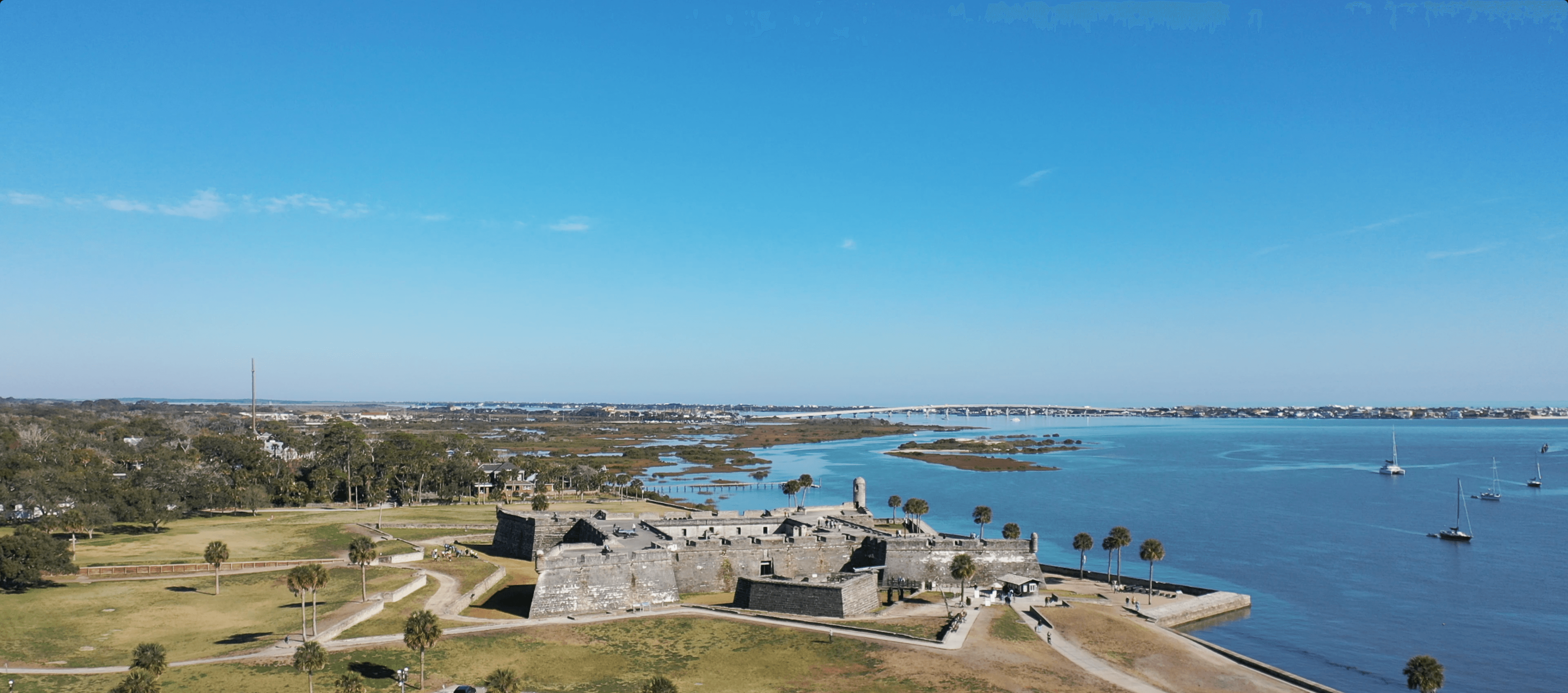
Once England had control of the Peninsula, they converted Monasteries into Barracks, and let Missions fall into disarray. Their rule would only last twenty years. Even still, the Catholic Hispanic population continued to live their faith. Famously, the Minorcans (descending from the Spanish island of Minorca in the Mediterranean) gave an example of incredible tenacity. They were brought as slaves by a Scottish Lord, Andrew Turnbull. They also had a Minorcan priest with them, Fr. Pedro Camps, who became a Moses-like figure. The Minorcans led a march to St Augustine, an exodus from their captivity. Fr. Camps would be with his flock in that city until his death. Many of the people living in the area can trace their ancestry back to these Minorcan settlers. Their bravery is commemorated in a statue outside the Cathedral Basilica of Saint Augustine.
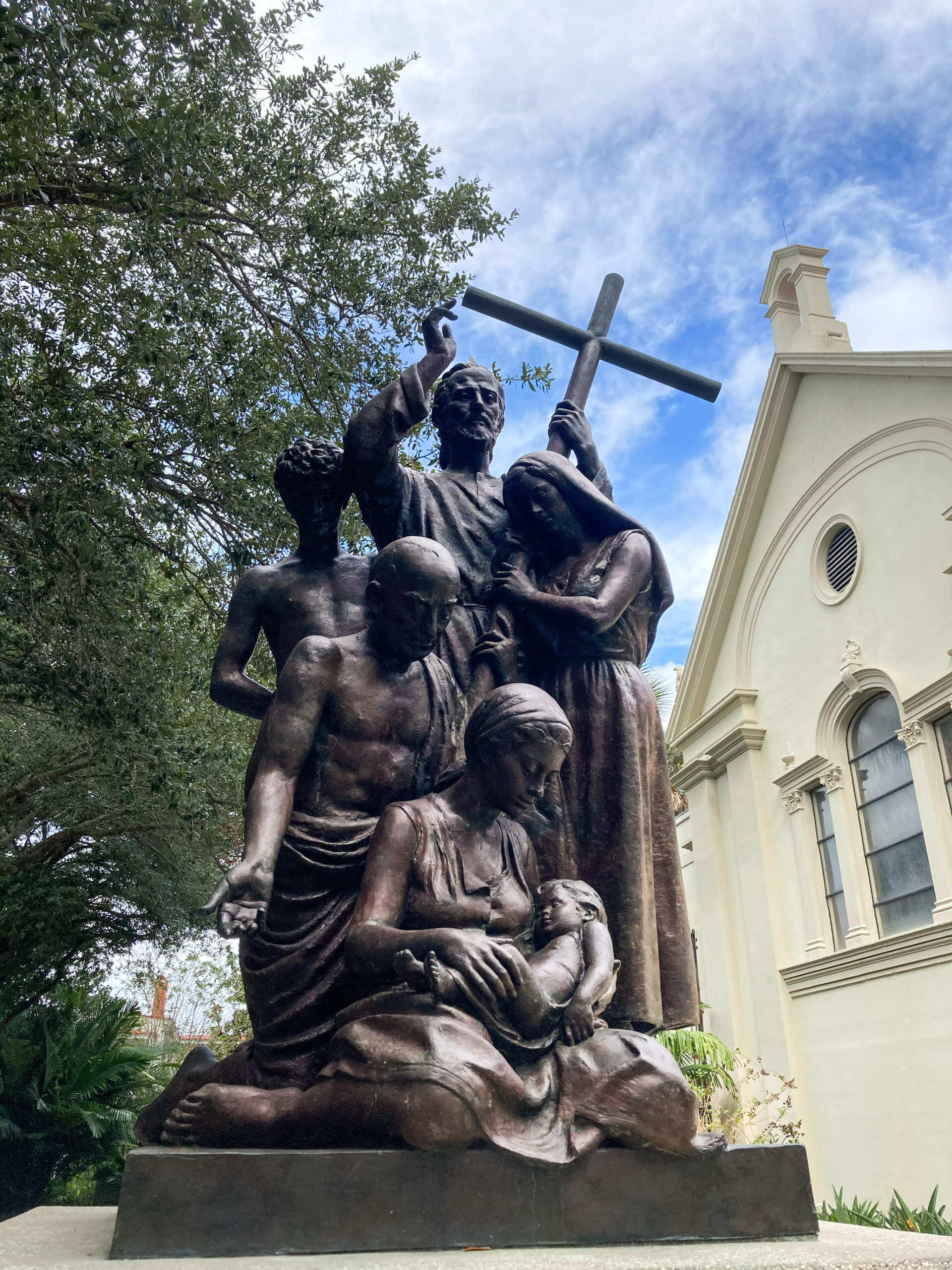
The Return of Florida to the Catholic Crown
But the Spanish did not give up on Florida. During the American Revolution, the British colony of Florida (that forgotten and erased 14th British colony), would side with the Loyalists in the war. As such, George Washington worked with the Spanish General Bernardo de Gálvez, who led the campaigns against the Loyalists in the Southern Theater. We often hear about the other campaigns, but we never hear about this one. Gálvez would win decisively against the British, and winning the “Reconquista.” As a result the American founding fathers would return control of Florida to Spain. It is not an exaggeration to say that without this alliance with Spain, the American War for Independence may have ended in a devastating failure.
However, shortly after, Napoleon would invade Spain, which led to the Spanish having to fight a war for their own independence. This power vacuum is what led to the Revolutions throughout Hispanic America. This would not go unnoticed by the newly formed United States, which would not respect the borders of Florida, and send in settlers. Americans would often send in search parties to capture runaway slaves, who lived in freedom due to Spanish laws. At the same time, the Seminole tribe fought hard against new settlers. Florida quickly became the “Wild West,” before the Wild West. A frontier society where every segment of civilization and peoples duked it out. The American military was often sending incursion into Florida. Eventually, in 1821, a battered and bruised Spain would have no other option but to sell the lands, as the Americans were clearly determined to own Florida, with or without the cooperation of Spain. From 1513 to 1821, the Spanish presence in Florida existed for nearly three centuries. But as Liberalism and revolutionary nations took over power globally, so would happen in Florida.
Lay Catholic Florida Semper Fidelis
Throughout the centuries, Florida would continue to be a frontier, a place that was as hard for the Americans to conquer as it was for the Spanish. The wars against the natives would continue for decades, but the Seminoles would be undefeated, even to this day.
In the transfer of power, the oldest Catholic community would be dispossesed of much their property, church buildings and livelihoods. They would face discrimination from the new arrivals. St Augustine, once the hub for a vast network of missions, would become the last lone parish in the region. For many years, the Catholics of Florida would find themselves without shepherds, organizing themselves to the best of their ability.
The peninsula would see much trouble in trying to organize its religious administration. Due to political and ecclesiastical confusion along with mismanagement, the area would be left in limbo, without a Bishop, and even without priests due to untimely deaths. However, the Catholics of Florida showed tenacity, and held on to the faith and traditions of their forefathers.
Left without shepherds, they became similar to the Catholics of Japan, catechizing the next generations and passing along customs, with the occasional brave priest venturing into the swampy lands to provide for the suffering community. What followed was a rocky period, one that seemed hopeless, as lay faithful would attempt to manage their community, with all the ups and downs that electing a board to lead the flock brings with it. It would’ve seemed like the end was near for them, but eventually the rightly ordered ecclesiastical authorities would set things right.
The Return of the Clergy and Catholic Growth
Throughout its history, Florida was administered by Bishops in Cuba, Louisiana, Baltimore, etc. It wasn’t until 1870 that Florida would get a diocese all its own, Pope Pius IX would establish the diocese of St Augustine and appoint Augustin Verot as the Bishop. Perhaps surprisingly, Floridian cities would stay largely limited to the very Northern tip of the Peninsula, except for some notable cities like Key West and Tampa.
In fact, in the 1880s, Tampa would become home to a vibrant Hispanic Community, more than half a century before Miami, with its Hispanic Tampeños being mainly Cuban and Spanish. A wealthy Spanish entrepreneur and industrialist by the name of Vicente Martínez Ybor would transfer his cigar manufacturing business from Cuba to Key West and then to Tampa. He bought acres of land that lined the Tampa Bay (once called Bahía del Espíritu Santo – “Bay of the Holy Spirit” by the early explorers). The community of Ybor City would be founded, whose main claim to fame was authentic Cuban cigarmaking. In this period, Catholic Churches would be built to keep up with the demands of the immigrants, especially the Catholics from Cuba, Spain and Italy.
Despite having some small cities sprinkled throughout the peninsula, the rest of Florida largely remained covered in thick wilderness. It wasn’t until the 1900s when Henry Flagler made the railroad stretch across South along the coast that the rest of the Peninsula would finally be built up. The sparsely populated peninsula would begin to look more like the Florida we know today.
The Catholics of Florida have been nothing but courageous, even despite difficulties and persecutions. Even in the 1910s, when Florida elected Governor Sidney J. Catts, who ran on an explicitly anti-Catholic platform, Bishop Curley of St. Augustine would stand up and defend the faith. His effort became noted by the country. And Florida saw its first big growth in the 1920s, with parishes increasing in number.
Legacy
After the Second World War, Catholicism would make its comeback in earnest, with parishes being built all over the state, and new dioceses needing to be created. The Catholic population boomed. At the same time, in the 1960s, Cubans would flee en masse from their island due to the Communist Revolution by Castro, a mass exodus to Florida. One cannot help but remember the mass exodus of Hispanic Floridians to Cuba in the 1760s. How many of the Cubans exiles were of old Floridian stock?
Almost poetically, the US would launch rockets from Cape Canaveral, Florida. Hundreds of years ago, the Spanish would launch their ships and land in Florida, and now the Floridians would launch spaceships and land on the Moon. In 1969, the Bishop of Orlando, Donald Borders, would jokingly tell Pope Paul VI that according to the Code of Canon Law of 1917, he was now Bishop of the Moon as well. Succeeding Bishops of Orlando have continued this claim of Ecclesiastical Control of the Moon. The fascinating Catholic History of Florida certainly did not end with Spanish. The spirit of adventure and exploration live on.
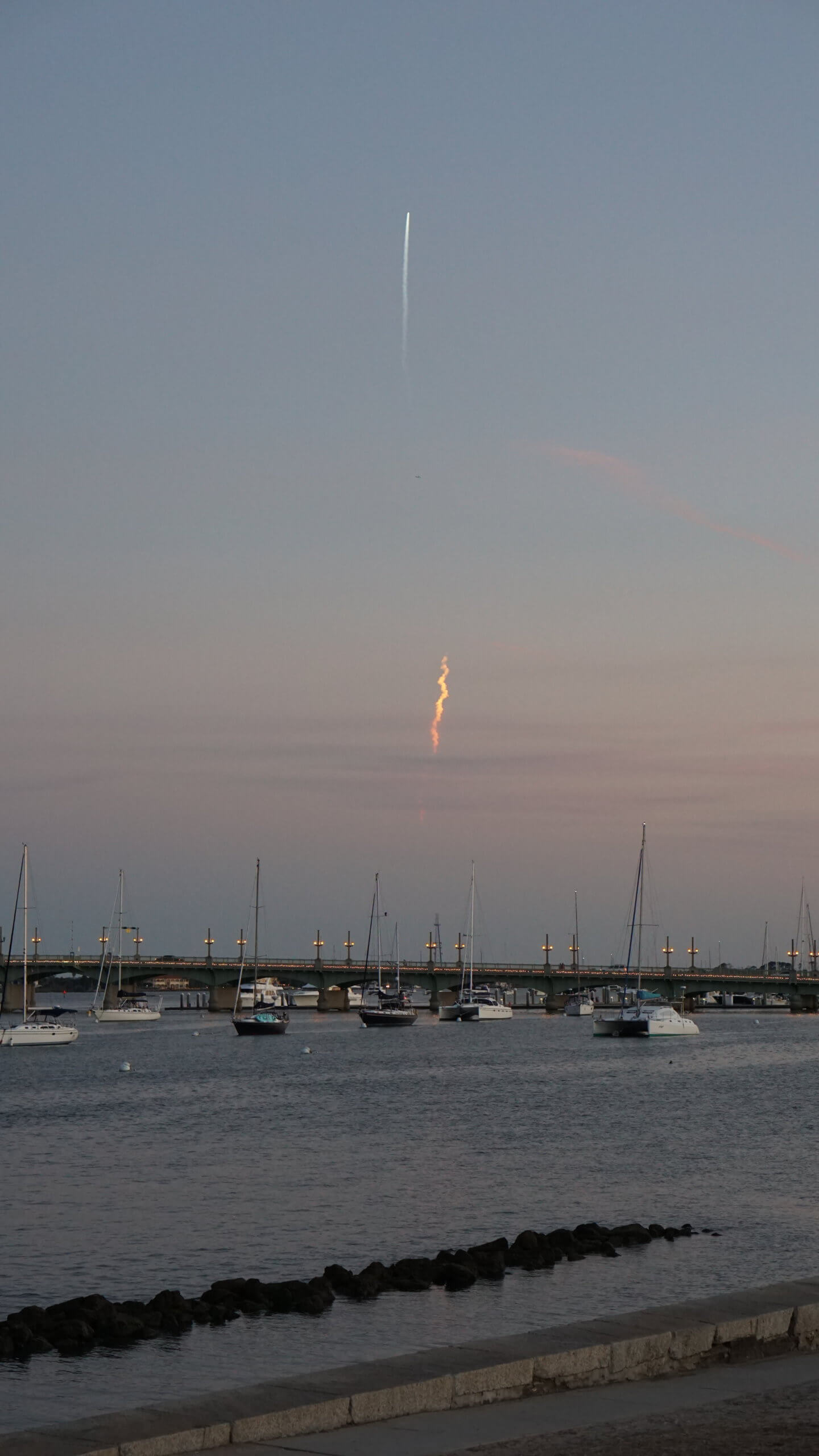
Hispanidad: Hidden Origins of America
The American mythos has not been built off of Florida, in fact, the American mythos has largely ignored Florida. But in it we see the same sense of adventure, anger and frontiersmanship that characterize the American mythos. As we increasingly see Florida become more and more important in American society, we must also remember the past of Florida so that it can inform our future.
Today, in the city of St. Augustine, there still stands a mission that was founded long ago, one the many of that by-gone era, yet we see a devotion established there that lives on to this day. It is placed right next to the sight of the original mass, in what is called the “Sacred Acre.” There, among the trees and thick shrubbery is Mission “Nombre de Dios” (Name of God). Inside the humble chapel, there is a statue of Our Lady of “La Leche y Buen Parto.” A medieval depiction of the Most Blessed Virgin, nursing the Infant Jesus.

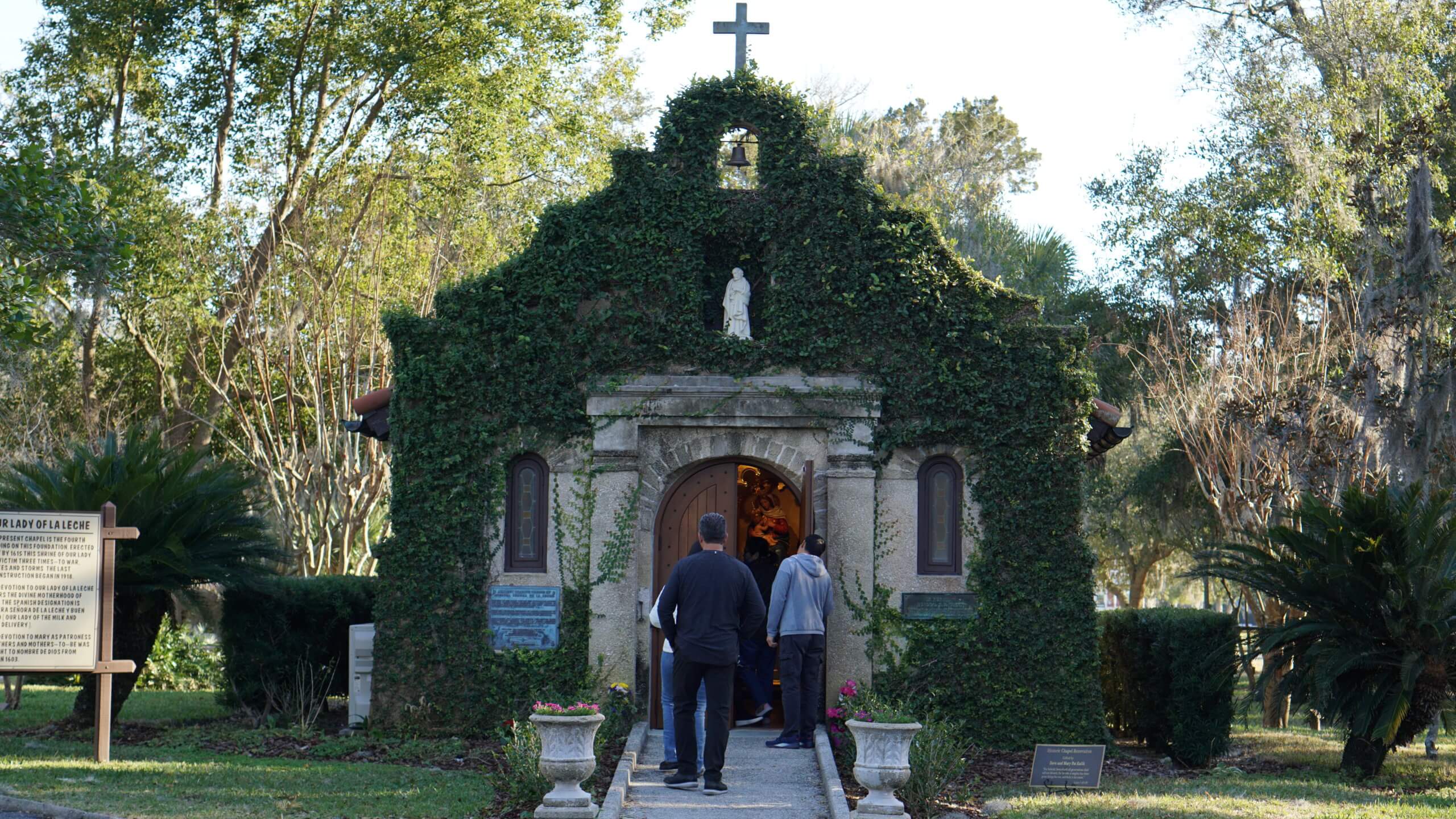
This mission and the statue have become miraculous, with many attesting to miracles regarding the conception of a child after struggling with infertility. I also see this devotion as one which can help us today as a civilization. It seems that the Lord wanted this devotion to inform the city as well, as it was literally “birthing” a new civilization, a Catholic society at the “edge of Christendom.” In many ways, we need to have devotion to Our Lady of La Leche as well, as we ask for our American society to be “reborn,” being purged of all the evils it promotes and instead becoming like that initial Christian society, which respected the law of God above all else. May the America of tomorrow be more Catholic, and may it borrow some of its mythos from the men and women who died with the goal of expanding Christendom into the New World.
Our Lady of La Leche, pray for us.

Editor’s note: for more on the Catholic Founding of North America and the continental United States including by the French and Catholic English, see the work of our contributing editor, Charles Coulombe: Puritan’s Empire: A Catholic Perspective on American History.

